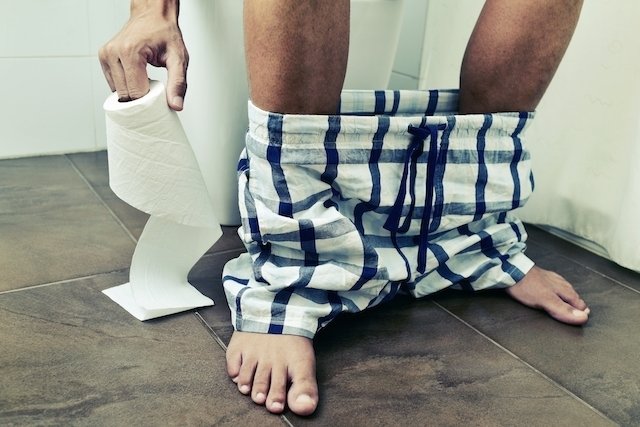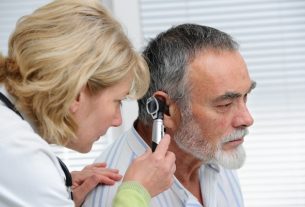Rectal prolapse is when the inner part of the rectum comes out through the anus and becomes visible on the outside of the body, causing symptoms such as abdominal pain, burning in the anal region, difficulty in evacuating and a feeling of heaviness in the anus.
Rectal prolapse can be a consequence of weakening of the anal muscle due to aging, too much effort to evacuate, constipation or be a consequence of intestinal parasite infection, for example.
It is important that the proctologist is consulted so that an evaluation can be carried out and the most appropriate treatment can be indicated, which may involve compression of the buttocks, manual reintroduction by the doctor or surgery, depending on the severity of the prolapse.

Rectal prolapse symptoms
The main symptoms of rectal prolapse are:
- Presence of dark red, moist, tube-shaped tissue outside the anus;
- Dor abdominal;
- Sensation of a mass in the anus;
- Burning, bleeding, discomfort and feeling of heaviness in the anus;
- Difficulty defecating;
- Sensation of incomplete evacuation.
In the presence of symptoms possibly indicative of rectal prolapse, it is important to consult a proctologist or gastroenterologist for an evaluation. Know how to recognize the symptoms of rectal prolapse.
It should be remembered that rectal prolapse should not be confused with hemorrhoids. In the case of rectal prolapse, the final part of the intestine can be seen outside the body through the anus, while hemorrhoids appear when the veins in the intestine dilate and protrude outside. Learn more about how to know if it is hemorrhoids and what to do.
How the diagnosis is made
To confirm the diagnosis of rectal prolapse, the coloproctologist or gastroenterologist performs a proctological examination, through which the prolapse in the anal orifice is observed. See how the proctological exam is performed.
In some cases, tests such as colonoscopy, sigmoidoscopy or x-rays with contrast may be requested to facilitate confirmation and observe the extent of the problem.
Make an appointment with your nearest doctor using the following tool to investigate the possibility of rectal prolapse:
Taking care of your health has never been easier!
Types of rectal prolapse
According to its characteristics, rectal prolapse can be classified into two types:
- Partial rectal prolapse: when only the mucous lining layer of the intestine is exposed. In these cases, it may be more difficult to visualize the prolapse;
- Total rectal prolapse: when all its layers are externalized, leading to a large volume of the rectum outside the body.
It is important that the type of rectal prolapse is identified so that the doctor can recommend the most appropriate treatment for the situation, promoting symptom relief.
Main causes
Rectal prolapse is more common in people over 60 years of age due to aging and loss of muscle strength in the region. In children under 3 years of age, rectal prolapse usually occurs due to weakness of the muscles and ligaments that support the intestine.
However, other possible causes of rectal prolapse are:
- Constipation;
- Intense effort to evacuate;
- Weakening of the anus muscle;
- Intestinal worm infection Trichuris trichiura;
- Intestine malformations;
- Excessive weight loss.
Furthermore, prolapse can also occur whenever there is a change in the region’s anatomy, due to surgery, childbirth, injury or disease, such as prostate enlargement or intestinal malformation.
Is rectal prolapse in children normal?
Infantile rectal prolapse is relatively common in children up to 3 years of age, due to the muscles and ligaments that support the rectum are still being formed and are therefore not strongly fixed to the abdominal wall, and when the child has frequent diarrhea , the rectal wall prolapses and becomes exteriorized.
In this case, the treatment for rectal prolapse in children simply consists of reinserting the rectum, as as the child grows, the rectum will be properly fixed to the wall. Furthermore, it can also be associated with infections, poor nutrient absorption and constant constipation. Learn more about the symptoms and treatment of this type of prolapse.
How the treatment is carried out
Treatment for rectal prolapse must be guided by the gastroenterologist according to the severity of the situation. In general, treatment includes compression of the buttocks to try to reintroduce the rectum into the anus or, if necessary, manual reintroduction of the rectum by a proctologist.
In cases where rectal prolapse is caused by constipation, treatment also includes laxative medications, increasing the intake of foods rich in fiber and drinking about 2 liters of water per day, to try to reduce the effort to evacuate and try to ensure that the problem does not happen again.
Surgery for rectal prolapse is also an option, but it is only indicated as a last resort and, in cases of frequent rectal prolapse, and in surgery, part of the rectum can be removed or fixed to the sacrum bone, so that there is no more prolapse.
Is rectal prolapse curable?
Rectal prolapse can be cured, and its treatment includes regularizing bowel function and reintroducing the rectum into the anus through surgery. In children, it is common for there to be spontaneous improvement with growth, and it is only advisable to receive guidance from a pediatrician or proctologist.





